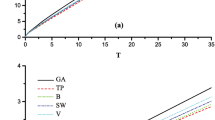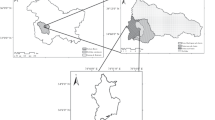Abstract
The effects of the concentration of total suspended solids from municipal wastewater on the water infiltration process in a clayey soil were investigated as well as the suitability of infiltration models with different numbers of parameters. The experiment consisted of columns of soil of 20 cm long in which supply water and synthetic municipal wastewater with different concentrations of solids were applied. The soil was characterized with respect to particle size, porosity, soil and particle density, clay water-dispersed clay, and infiltration capacity. The accuracy of the Kostiakov, Kostiakov-Lewis, Horton, Phillip, Green-Ampt, and Swartzendruber infiltration models was assessed by using the statistical criteria: mean error (MAE), mean squared error (RMSE), determination coefficient (R2), index of agreement (d), and Akaike information corrected criterion (AICc). The results indicate that the application of wastewater rich in suspended solids reduces the macroporosity of the soil, due to the clogging of the pores, causing a reduction in the hydraulic conductivity of the saturated soil and the cumulative infiltration. Based upon the AICc, the Kostiakov-Lewis models proved to be the most appropriate, except for the treatment with the highest concentration of solids, in which the Swartzendruber model presented the lowest AICc. In general, the other statistical criteria corroborate this conclusion.


Similar content being viewed by others
Data Availability
The dataset analyzed during the current study is not publicly available due to the corresponding author does not possess full rights to the entire dataset, but it may be available on a reasonable request.
References
Alade, A.O., Jammel, A.T., Muyubi, S.A., Karim, M.I.A. & Alam, M.Z.(2011) Removal of oil and grease as emerging pollutants of concern (epc) in wastewater stream. Engineering Journal. https://doi.org/10.31436/iiumej.v12i4.218
Albalasmeh, A.A., Gharaibeh, M.A., Alghzawi M., Morbidelli, R., Saltalippi, C., Ghezzehei, T.A., Flammini, A. (2020) Using wastewater in irrigation: The effects on infiltration process in a clayey soil. Water. https://doi.org/10.3390/w12040968
Alvárez, J.C.D.& Cisneros, B.J. (2014) Beneficial and negative impacts on soil by the reuse of treated/untreated municipal wastewater for agricultural irrigation – A review of the current knowledge and future perspectives. In: Hernandez Soriano MC (ed) Environmental risk assesment of soil in Tech , (pp. 137–197), Croatia
Alves, P.F.S., Santos, S.R., Kondo, M.K., Pegoraro, R.F., Araújo, E.D. (2015) Soil physical attributes in chemigated banana plantation with wastewater. Engenharia Agricola. https://doi.org/10.1590/1809-4430-Eng.Agric.v35n6p998-1008/2015
Aman, M.S., Jafari, M. & Reihan, M.K., Motesharezadeh, B., Zare, S. (2018) Assessing the effect of industrial wastewater on soil properties and physiological and nutritional responses of Robinia pseudoacacia, Cercis siliquastrumand Caesalpinia gilliesii seedlings. Journal of Environmental Management. https://doi.org/10.1016/j.jenvman.2018.03.087
American Public Health Association (APHA); American Water Works Association (AWWA); Water Environment Federation (WEF). (2012). Standard Methods for the Examination of Water and Wastewater (22nd ed.).
Araghi, F.P., Mirlatifi, S.M., Dashtaki S.G., Mahdian, M.H. (2013) Point estimation of soil water infiltration process using artificial neural networks for some calcareous soils. Journal of Hydrology. https://doi.org/10.1016/j.jhydrol.2012.12.007
Bardhan, G., Russo, D., Goldstein, D. & Levy, G.J. (2016). Changes in the hydraulic properties of a clay soil under long-term irrigation with treated wastewater. Geoderma. https://doi.org/10.1016/j.geoderma.2015.10.004
Bedbabis, S., Rouina, B.B.,Boukhris, M. & Farrara, G. (2014). Effect of irrigation with treated wastewater on soil chemical properties and infiltration rate. Journal of Environmental Management. https://doi.org/10.1016/j.jenvman.2013.11.007
Bhardway, A.K., Goldstein, D., Azenkot, A. & Levy, G.J. (2007). Irrigation with treated wastewater under two different irrigation methods: Effects on hydraulic conductivity of a clay soil. Geoderma. https://doi.org/10.1016/j.geoderma.2007.04.003
Bolster, C.H. & Hornberger, G.M. (2007). On the use of linearized Langmuir equations. Soil Science Society of America Journal. https://doi.org/10.2136/sssaj2006.0304
Bourazanis, G., Katsileros, A., Kosmas, C. & Kerkides, P. (2016). The effect of treated municipal wastewater and fresh water on saturated hydraulic conductivity of a clay-loamy soil. Water Resources Management. https://doi.org/10.1007/s11269-016-1307-9
Campos, B.C. de; Amado, T.J.C.; Bayer, C.; Nicoloso, R. da S. Fiorin, J.E. (2011) Carbon stock and its compartments in a subtropical oxisol under long-term tillage and crop rotation systems. Revista Brasileira de Ciência do solo. https://doi.org/10.1590/S0100-06832011000300016
Carvalho, R., Silva, M.L.N., Avanzi, J.C., Curi, N.& Souza, F.S.(2009) Erosão hídrica em latossolo vermelho sob diversos sistemas de manejo do cafeeiro no Sul de Minas Gerais. Ciência e Agrotecnologia. https://doi.org/10.1590/S1413-70542007000600012
Coppola, A., Santini, A., Vacca, S., Comegna, V., Severino, G. (2004) Methodological approach for evaluating the response of soil hydrological behavior to irrigation with treated municipal wastewater. Journal of Hidrology. https://doi.org/10.1016/j.jhydrol.2003.12.028
Empresa Brasileira de Pesquisa Agropecuária - EMBRAPA. (2017). Centro Nacional de Pesquisa de Solos. Manual de métodos de análise de solo. 3. ed. Rev. atual. Rio de Janeiro: Embrapa Solos, 574 p
Empresa Brasileira de Pesquisa Agropecuária - EMBRAPA. (2018) Centro Nacional de Pesquisa de Solos. Sistema Brasileiro de Classificação do Solo. 5 ed. Rev atual. Rio de Janeiro: Embrapa Solos, 355 p.
Ferreira, D.F. (2011). Sisvar: A computer statistical analysis system. Ciência e Agrotecnologia. https://doi.org/10.1590/S1413-70542011000600001
Ghanbarian-Alavijeh, B. & Liaghat, A.M., (2009). Evaluation of soil texture data for estimating soil water retention curve. Canadian Journal of Soil Science. https://doi.org/10.4141/cjss08066
Green W.H & Ampt C.A. (1911). Studies on soil physics, I. Flow of air and water through soils. Journal Agricultural Science. https://doi.org/10.1017/S0021859600001441
Guo, X., Zhao, T., Liu,L., Xiao, C.& He, Y. (2018) Effect of sewage irrigation on the CT-measured soil pore characteristics of a clay farmland in Northern China. International Jornal of Environmental and Public Health. https://doi.org/10.3390/ijerph15051043
Horton R.E. (1940). Approach toward a physical interpretation of infiltration capacity. Soil Science Society American Journal. https://doi.org/10.2136/sssaj1941.036159950005000C0075x
Kostiakov, A. N. (1932). On the dynamics of the coefficients of water percolation in soils. Sixth Commission for International Society Soil Science, Part A, 42, 15–21.
Lado, M. & Ben-Hur, M. (2009) Treatment domestic sewage irrigation effects on soil hydraulic properties in arid and semiarid zones: A review. Soil & Tillage Research. https://doi.org/10.1016/j.still.2009.04.011
Leuther, F., Schluter, S., Wallach, R. & Vogel, H.J. (2018) Quantitative analyses of wetting front instabilities in soil caused by treated waste water irrigation. Geoderma. https://doi.org/10.1016/j.geoderma.2018.01.004
Levy, G.J., Fine, P., & Bar-tal, A., (2011). Treated wastewater in agriculture: use and impacts on the soil environment and crops. https://doi.org/10.1002/9781444328561
Magesan, G.N., Williamson, J.C., Yeates, G.W. & Lloyd-Jones, A.R. (2000) Wastewater C:N ratio effects on soil hydraulic conductivity and potential mechanisms for recovery. Bioresource Technology. https://doi.org/10.1016/S0960-8524(99)00054-1
Mezencev, V. J. (1948). Theory of formation of the surface runoff (In Russian). Meteorolgia E Hidrologia, 3, 33–40.
Mishra, S.K., Tyagi, J.V. & Singh, V.P., (2003). Comparison of infiltration models. Hydrological Processes. https://doi.org/10.1002/hyp.1257
Microsoft, 2010. Microsoft Office Word. Computer software. Microsoft. Vers. 2010 [online]. Available from: https://www.microsoft.com/pt-br/ [Accessed 25 September 2020]
Mirzaee, S.; Zolfaghari, A.A.; Gorji, M.; Dyck, M.& Dashtaki, S.G. (2014). Evaluation of infiltration models with different numbers of fitting parameters in different soil texture classes. Archives of Agronomy and Soil Science. https://doi.org/10.1080/03650340.2013.823477
Moraes, M.T., Debiasi, H., Franchini, J.C., Mastroberti, A.A., Levien, R.; Leitner, D. & Schnepf, A. (2020).Soil compaction impacts soybean root growth in an Oxisol from subtropical Brazil. Soil & Tillage Research. https://doi.org/10.1016/j.still.2020.104611
Parkesian, M. P. S. (2003) Aplicação de lise celular forçada em sistema de tratamento aeróbio precedido de reator UASB. Thesis (Doctorate) – São Carlos Engineering School, University of de São Paulo, São Carlos.
Philip J.R. (1957). The theory of infiltration: 2. The profile at infinity. Soil Science. https://doi.org/10.1097/00010694-195706000-00003
Razzagui, S., Khodaverdiloo, H., Dashtaki, S.H. (2016). Effects of long-term wastewater irrigation on soil physical properties and performance of selected infiltration models in a semi-arid region. Hydrological Science Journal. https://doi.org/10.1080/02626667.2015.1051981
Redman ,S., Ormerod, K.J.& Kelley, S. (2019). Reclaiming suburbia: Differences in local identity and public perceptions of potable water reuse. Sustentabily. https://doi.org/10.3390/su11030564
Sahu, R. K., Kumar, S., & Alam, A. (2013). Evaluation of effect of wastewater application on saturated hydraulic conductivity of soil. Indian Journal of Soil Conservation, 41(3), 212–218.
Silva, A.A. & Castro, S.S. (2015).Indicadores macro e micromorfológicos da qualidade física de um latossolo vermelho cultivado com cana-de-açúcar. Mercator, 0.5216/bgg.v34i2.31731
Souza, J. A. A. De, Batista, R. O., Ramos, M. M.& Soares, A. A. (2010) Alteração nas características físicas do solo decorrentes da aplicação de esgoto doméstico tratado. Acta Scientiarum. Technology. https://doi.org/10.4025/actascitechnol.v32i4.5349
Swartzendruber D. (1987). A quasi-solution of Richards equation for the downward infiltration of water into soil. Water Resources Research. https://doi.org/10.1029/WR023i005p00809
Von Sperling, M. (2014). Introdução á qualidade das águas a ao tratamento de esgotos. Belo Horizonte, MG: Editora UFMG, 452 p.
Vörösmarty, C.J.& McIntyre, P.B.; Gessener, M.O.; Dudgeon, D.; Prusevich, A.; Green, P.; Glidden, S.; Bunn, S.E.; Sullivan, C.A.; Liermann, C.R.; Davies, P.M.(2010). Global threats to human water security and river biodiversity. Nature. https://doi.org/10.1038/nature09440
Wang, Z., Li, J.& Li, Y. (2017).Using reclaimed water for agricultural and landscape irrigation in China: A review. Irrigation and Drainage. https://doi.org/10.1002/ird.2129
Willmont, C.J., (1981). On the validation of models. Physical Geography. https://doi.org/10.1080/02723646.1981.10642213
Zhang, Y.& Shen, Y. (2017) Wastewater irrigation: Past, present, and future. Wiley Interdisciplinary. https://doi.org/10.1002/wat2.1234
Zolfaghari, A.A, Mirzaee ,S. & Gorji, M. (2012). Comparison of different models for estimating cumulative infiltration. International Journal Soil Science. https://doi.org/10.3923/ijss.2012.108.115
Author information
Authors and Affiliations
Corresponding author
Additional information
Publisher’s Note
Springer Nature remains neutral with regard to jurisdictional claims in published maps and institutional affiliations.
Rights and permissions
About this article
Cite this article
Andrade, J.F.C., de Oliveira, L.F.C. & Silva, J.R.M.e. Evaluation of Infiltration Models with Different Numbers of Adjustment Parameters in an Oxisol with Application of Wastewater at the Different Concentrations. Water Air Soil Pollut 232, 323 (2021). https://doi.org/10.1007/s11270-021-05255-4
Received:
Accepted:
Published:
DOI: https://doi.org/10.1007/s11270-021-05255-4




